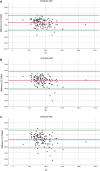Effect of voxel size in cone-beam computed tomography on surface area measurements of dehiscences and fenestrations in the lower anterior buccal region
- PMID: 35513582
- PMCID: PMC9474376
- DOI: 10.1007/s00784-022-04521-x
Effect of voxel size in cone-beam computed tomography on surface area measurements of dehiscences and fenestrations in the lower anterior buccal region
Abstract
Objectives: This study aims to assess whether different voxel sizes in cone-beam computed tomography (CBCT) affected surface area measurements of dehiscences and fenestrations in the mandibular anterior buccal region.
Materials and methods: Nineteen dry human mandibles were scanned with a surface scanner (SS). Wax was attached to the mandibles as a soft tissue equivalent. Three-dimensional digital models were generated with a CBCT unit, with voxel sizes of 0.200 mm (VS200), 0.400 mm (VS400), and 0.600 mm (VS600). The buccal surface areas of the six anterior teeth were measured (in mm2) to evaluate areas of dehiscences and fenestrations. Differences between the CBCT and SS measurements were determined in a linear mixed model analysis.
Results: The mean surface area per tooth was 88.3 ± 24.0 mm2, with the SS, and 94.6 ± 26.5 (VS200), 95.1 ± 27.3 (VS400), and 96.0 ± 26.5 (VS600), with CBCT scans. Larger surface areas resulted in larger differences between CBCT and SS measurements (- 0.1 β, SE = 0.02, p < 0.001). Deviations from SS measurements were larger with VS600, compared to VS200 (1.3 β, SE = 0.05, P = 0.009). Fenestrations were undetectable with CBCT.
Conclusions: CBCT imaging magnified the surface area of dehiscences in the anterior buccal region of the mandible by 7 to 9%. The larger the voxel size, the larger the deviation from SS measurements. Fenestrations were not detectable with CBCT.
Clinical relevance: CBCT is an acceptable tool for measuring dehiscences but not fenestrations. However, CBCT overestimates the size of dehiscences, and the degree of overestimation depends on the actual dehiscence size and CBCT voxel size employed.
Keywords: Accuracy; Cone-beam computed tomography; Dehiscence; Fenestration; Reliability.
© 2022. The Author(s).
Conflict of interest statement
The authors declare no competing interests.
Figures






